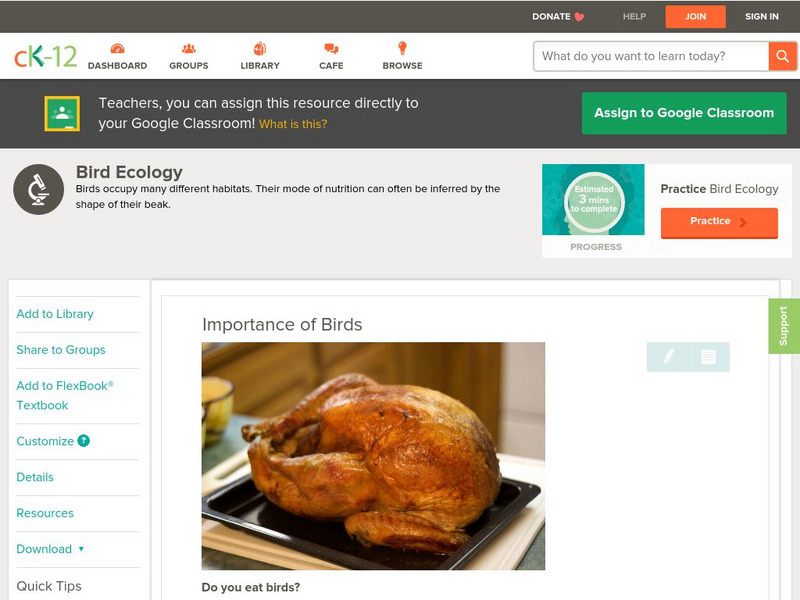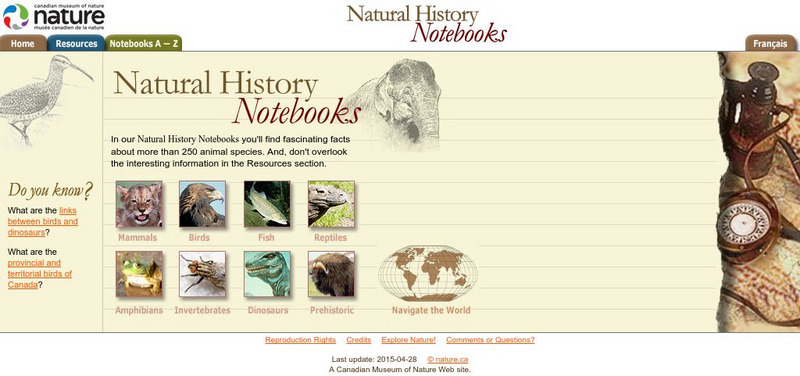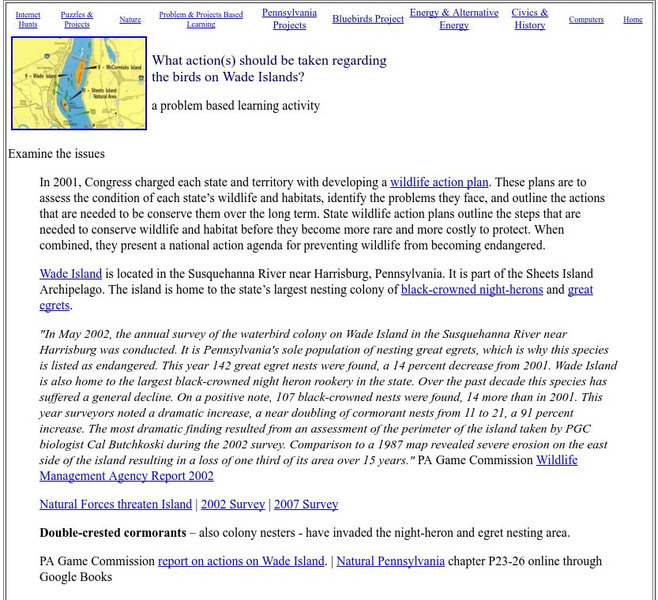American Museum of Natural History
American Museum of Natural History: California Condor O Logy Card
Flip this interactive OLogy card to start learning about the California condor. Review some fast facts about condors and answer multiple-choice and fact-or-fiction questions to test your understanding.
CK-12 Foundation
Ck 12: Life Science: Importance of Birds
[Free Registration/Login may be required to access all resource tools.] You are probably familiar with birds as food. Around the world, people consume chicken, turkey, and even more exotic birds, like ostriches. Can you think of other...
PBS
Nh Pbs: Nature Works: Little Blue Heron
Find out more about the Little Blue Heron through this educational resource. The content of this source includes information on behavior, characteristics, life cycle, diet, habitat and range.
Canadian Museum of Nature
Canadian Museum of Nature: Natural History Notebooks
This site from the Canadian Museum of Nature, a natural history museum, provides short information blurbs and fun facts on over 240 different common animals categorized by type (mammals, fish, reptiles, invertebrates, amphibians,...
Cynthia J. O'Hora
Mrs. O's House: What Actions Should Be Taken for Wade Island Birds?
Examine efforts of national, state, and local governments to protect birds in their natural habitats.
Cynthia J. O'Hora
Mrs. O's House: American Bald Eagle Status in Your State
What is the status of the bald eagle in your state? Investigate the population of the once endangered national bird in the states. Understand why birds of prey are protected in the United States.
PBS
Pbs Teachers:flying Casanovas: Bowerbird Basics
Examine characteristics of bowerbirds and their bowers. Compare and contrast various styles of bowers created by bowerbirds
EL Education
El Education: Bird Cards
This set of note cards was created by kindergarten students from the Anser Public Charter School in Boise, Idaho, as part of a year-long Learning Expedition on birds. Each student became a specialist in his or her specific species of...
HotChalk
Hot Chalk: Lesson Plans Page: Bird Houses Making a Book
This lesson is designed to introduce young students to the various places birds might live and to have them visually represent them in a book form.
HotChalk
Hot Chalk: Lesson Plans Page: Billie Bird Learning About a Bird's Body
This lesson is designed to introduce young students to the various parts of bird anatomy and to express that through creative movement, poetry, and drawings.
Curated OER
Greater Yellowlegs
Come and discover what the Greater Yellowleg looks like through these photographs. The content of this resource includes a look at this species' characteristics, range, habitat, food, and more.
Curated OER
Greater Yellowlegs
Come and discover what the Greater Yellowleg looks like through these photographs. The content of this resource includes a look at this species' characteristics, range, habitat, food, and more.
Curated OER
Greater Yellowlegs
Come and discover what the Greater Yellowleg looks like through these photographs. The content of this resource includes a look at this species' characteristics, range, habitat, food, and more.
Curated OER
Greater Yellowlegs
Come and discover what the Greater Yellowleg looks like through these photographs. The content of this resource includes a look at this species' characteristics, range, habitat, food, and more.
Curated OER
Green Heron
What makes the green heron unique? Come and discover more about this aquatic bird when you explore this educational resource. This site includes information on diet, range, habitat, characteristics, behavior and life cycle.
Curated OER
Green Heron
What makes the green heron unique? Come and discover more about this aquatic bird when you explore this educational resource. This site includes information on diet, range, habitat, characteristics, behavior and life cycle.
Curated OER
Green Heron
What makes the green heron unique? Come and discover more about this aquatic bird when you explore this educational resource. This site includes information on diet, range, habitat, characteristics, behavior and life cycle.










